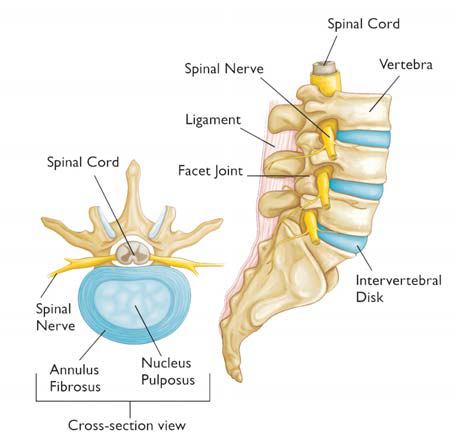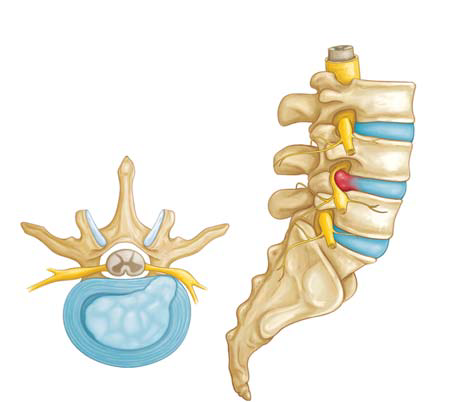A common source of back or neck pain is a herniated disc. Sometimes called a "slipped" or "ruptured" disc, this condition most often occurs in the lower back, as well as the smaller discs in the neck. Although a herniated disc can sometimes be very painful, most people feel much better with just a few months of simple, nonsurgical treatments.
What is the anatomy of the spinal disc?
Discs are soft, rubbery pads found between the hard bones (vertebrae) that make up the spinal cord. The discs between the vertebrae allow the back to flex or bend. Discs also act as shock absorbers.
Discs in the lumbar spine (low back) are composed of a thick outer ring of cartilage (annulus) and an inner gel-like substance (nucleus). In the cervical spine (neck), the discs are similar but smaller in size.

What causes a herniated disc?

A disc herniates or ruptures when part of the center gel-like nucleus pushes through the outer edge of the disc and back toward the spinal canal. This puts pressure on the nerves. Spinal nerves are very sensitive to even slight amounts of pressure, which can result in pain, numbness, or weakness in one or both legs.
In children and young adults, discs have high water content. As people age, the water content in the discs decreases and the discs become less flexible. The discs begin to shrink and the spaces between the vertebrae get narrower. Conditions that can weaken the disc include:
- Improper lifting
- Smoking
- Excessive body weight that places added stress on the discs (in the lower back)
- Sudden pressure (which may be slight)
- Repetitive strenuous activities
What are symptoms of herniated disc?
Low Back Pain
Low back pain affects many people. Pain alone is not enough to recognize a herniated disc. See your doctor if back pain results from a fall or a blow to your back. The most common symptom of a herniated disc is sciatica—a sharp, often shooting pain that extends from the buttocks down the back of one leg. It is caused by pressure on the spinal nerve.
Other symptoms include:
- Back pain
- Weakness in the leg and/or foot
- Tingling (a "pins-and-needles" sensation) or numbness in the leg and/or foot
- Loss of bladder or bowel control (This is rare and may indicate a more serious problem called cauda equina syndrome. This condition is caused by the spinal nerve roots being compressed. It requires immediate medical attention.)
Neck Pain
As with pain in the lower back, neck pain is also common. When pressure is placed on a nerve in the neck, it causes pain in the muscles between your neck and shoulder (trapezius muscles). The pain may shoot down the arm. Other symptoms include:
- Weakness in one arm
- Tingling (a "pins-and-needles" sensation) or numbness in one arm
- Burning pain in the shoulders, neck, or arm
Diagnosis
How is a herniated disc diagnosed?
To determine whether you have a herniated disc, your doctor will ask you for a complete medical history and conduct a physical examination.
A physical exam will help determine which nerve roots are affected.
To help confirm a diagnosis of herniated disc, your doctor may recommend a magnetic resonance imaging (MRI) scan. This test can create clear images of soft tissues like intervertebral discs.
How is a herniated disc treated without surgery?
Nonsurgical treatment is effective in treating the symptoms of herniated discs in the majority of patients. Most neck or back pain will resolve gradually with simple measures.
- Rest and over-the-counter pain relievers may be all that is needed.
- Muscle relaxers, analgesics, and anti-inflammatory medications are also helpful.
- Cold compresses or ice can also be applied several times a day for no more than 20 minutes at a time.
- After any spasms settle, gentle heat applications may be used.
Any physical activity should be slow and controlled, especially bending forward and lifting. This can help ensure that symptoms do not return, as can taking short walks and avoiding sitting for long periods. For the lower back, exercises may also be helpful in strengthening the back and abdominal muscles. For the neck, exercises or traction may also be helpful. To help avoid future episodes of pain, it is essential that you learn how to properly stand, sit, and lift.
If these nonsurgical treatment measures fail, epidural injections of a cortisone-like drug may lessen nerve irritation and allow more effective participation in physical therapy. These injections are given on an outpatient basis over a period of weeks.
How is a herniated disc treated with surgery?
If nonsurgical treatment does not work, surgery may be recommended.
Lumbar microdiscectomy. This is the most common procedure for a herniated disc in the lower back. Microdiscectomy involves removing the herniated part of the disc and any fragments that are putting pressure on the spinal nerve.
Cervical discectomy and fusion. Cervical discectomy is a procedure for the herniated disc in the neck. To relieve pressure, the entire herniated disc is removed. Bone is placed in the disc space and a metal plate may be used to help support the spine.
